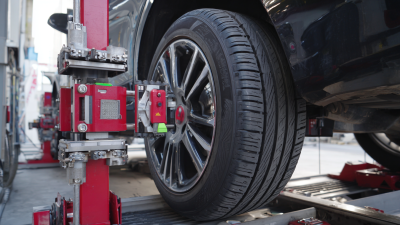The Real Factors Influencing Tire Alignment Cost: What Every Car Owner Should Know
When it comes to maintaining vehicle performance and safety, understanding tire alignment cost is essential for every car owner. According to the American Automobile Association (AAA), improperly aligned wheels can lead to increased tire wear, poor handling, and decreased fuel efficiency, with potential costs exceeding $600 over the lifespan of the tires. In fact, a report by the Tire Industry Association (TIA) indicates that up to 90% of vehicles on the road may experience misalignment at some point, significantly impacting overall maintenance costs. This introductory guide aims to shed light on the real factors influencing tire alignment cost, providing valuable insights for car owners to make informed decisions and ultimately save money while ensuring their vehicles operate at optimal efficiency. By understanding these elements, owners can better manage their vehicle maintenance and prolong tire lifespan, ultimately enhancing their driving experience.

Key Components Impacting Tire Alignment Expenses
Understanding the factors that influence tire alignment costs is essential for every car owner. One of the primary components that impacts these expenses is the type of vehicle. Different vehicles come with varying degrees of complexity in their suspension systems. For example, luxury cars and high-performance vehicles often require specialized parts and expertise, leading to higher alignment costs compared to standard sedans or compact cars.
Another significant factor is the local market condition. Prices can vary widely based on geographic location, as competition among auto shops and the cost of living in an area can drive alignment prices up or down. Additionally, the quality of service offered by the alignment shop plays a crucial role; reputable shops with experienced technicians may charge a premium, but they often provide a level of precision and reliability that cheaper alternatives may not offer. Overall, car owners should carefully evaluate these components when considering tire alignment services to ensure they receive quality service without overspending.
The Real Factors Influencing Tire Alignment Cost
This chart illustrates the key components impacting tire alignment expenses, showcasing the average costs associated with various factors, such as Misalignment, Wear and Tear, Suspension Issues, and Labor Costs.
Understanding the Role of Vehicle Type in Alignment Costs
When it comes to tire alignment costs, the type of vehicle you own plays a crucial role in determining the price. Generally, different vehicles have varying suspension systems and alignment geometries, which can influence labor and parts costs. For instance, luxury vehicles or those with complex suspension designs often require more specialized service and equipment, resulting in higher alignment fees. On the other hand, standard sedans and compact cars typically have simpler setups, making the alignment process quicker and less expensive.

Tips: When considering an alignment, check your vehicle’s manual for specific recommendations regarding alignment intervals. Regularly inspecting your tires for uneven wear can also be an excellent preventative measure, helping you catch alignment issues early and potentially saving you on costs.
Additionally, keep in mind that larger vehicles like trucks and SUVs may have different alignment specifications due to their size and weight. This can lead to increased costs for adjustments. Understanding these distinctions not only prepares you for the expenses ahead but also emphasizes the importance of regular maintenance tailored to your vehicle type.
Tips: Look for alignment shops that specialize in your vehicle’s make and model. They may offer better pricing or special packages that can provide both expertise and savings.
Common Misconceptions About Tire Alignment Pricing
When it comes to tire alignment, many car owners harbor misconceptions that can lead to confusion and unnecessary expenses. One prevalent myth is that tire alignment is only necessary when visible tire wear or steering issues occur. In reality, experts suggest that regular alignments are essential for vehicle maintenance, ideally every 6,000 to 10,000 miles, as this can help prevent uneven tire wear and extend tire life by 25%, according to the Tire Industry Association.
Another common misconception surrounds the cost of tire alignment. Many believe that alignment services are unreasonably expensive, ranging anywhere from $75 to $100 or more. However, understanding the factors that influence pricing, such as the vehicle's make, model, and the complexity of the alignment, is crucial. For instance, luxury vehicles with advanced suspension systems may incur higher alignment costs due to the required specialized equipment and expertise.
**Tips for Car Owners:**
1. Regularly check your tire pressure and tread depth, as these factors can influence alignment health and longevity.
2. Seek out a reputable service provider that offers a comprehensive alignment inspection, as a thorough evaluation can save you money in the long run.
3. Keep track of your vehicle's service records and performance; timely alignment can prevent costly repairs down the road.
The Real Factors Influencing Tire Alignment Cost: What Every Car Owner Should Know
| Factor | Description | Average Cost ($) |
|---|---|---|
| Type of Vehicle | Different types of vehicles (SUV, sedan, truck) may have varying alignment costs. | 75 - 150 |
| Alignment Type | 2-wheel alignment vs. 4-wheel alignment; typically, 4-wheel is more expensive. | 100 - 200 |
| Geographic Location | Prices may vary significantly based on city, state, or country. | 80 - 180 |
| Tire Condition | The condition of tires can affect alignment; worn tires may require additional adjustments. | 50 - 100 |
| Mechanic Experience | Highly experienced mechanics might charge more due to their expertise. | 90 - 200 |
| Labor Costs | Labor rates differ by shop and can increase total alignment costs. | 70 - 150 |
Factors Beyond Labor: The Hidden Costs of Tire Alignment
 When considering tire alignment, many car owners focus primarily on labor costs, overlooking several hidden factors that can significantly influence the overall price. One crucial element is the condition of the tires themselves. Worn or unevenly inflated tires can lead to complications during the alignment process, necessitating additional adjustments or replacements that drive up costs. Similarly, if the suspension system shows signs of wear, it may need repairs or replacements before achieving proper alignment, adding to the overall expenditure.
When considering tire alignment, many car owners focus primarily on labor costs, overlooking several hidden factors that can significantly influence the overall price. One crucial element is the condition of the tires themselves. Worn or unevenly inflated tires can lead to complications during the alignment process, necessitating additional adjustments or replacements that drive up costs. Similarly, if the suspension system shows signs of wear, it may need repairs or replacements before achieving proper alignment, adding to the overall expenditure.
Another often underestimated factor is the technology used in the alignment equipment. Some shops employ advanced alignment machines that provide more accurate measurements than standard models. While this can yield better long-term results for your vehicle, it could also mean higher service fees. Additionally, regional differences in service costs cannot be ignored; labor rates fluctuate significantly from one area to another, influencing what you might pay for tire alignment. Understanding these hidden costs can help car owners make informed decisions and potentially save money in the long run.
Tips for Car Owners to Minimize Tire Alignment Expenses
When it comes to maintaining your vehicle, tire alignment is an essential aspect that can significantly affect your overall driving experience and expenses. A study by the Tire Industry Association reveals that misaligned wheels can lead to increased tire wear, diminished fuel efficiency, and compromised safety. Understanding these factors can help car owners take proactive measures to minimize alignment costs.
To keep tire alignment expenses in check, regular inspections are crucial. According to the Automotive Service Association, having your alignment checked every 6,000 miles or whenever you replace tires can save you around 20% in replacement costs over the lifespan of your tires. Additionally, adopting good driving habits, such as avoiding potholes and rough terrain, can help prevent unnecessary misalignment. Maintaining proper tire pressure, as highlighted by the National Highway Traffic Safety Administration, also plays a significant role in ensuring even tire wear and longevity, which ultimately translates to fewer alignments needed.
Lastly, consider investing in high-quality tires and suspension components. A Consumer Reports analysis indicates that premium tires can enhance vehicle stability and alignment retention. Moreover, using trusted shops that prioritize quality services can lead to a longer-lasting alignment, protecting your investment and lowering long-term costs. By being proactive and informed, car owners can effectively manage tire alignment expenses while ensuring a smooth and safe ride.
Related Posts
-

Essential Tips for Choosing the Best Tire Repair Shop Near You
-

The Ultimate Guide to Choosing the Perfect Car Tyres for Every Season
-

Understanding Tire Alignment Cost: What Affects Pricing and Why It Matters for Your Safety
-

The Ultimate Guide to DIY Car Tyre Repair Techniques for Every Driver
-

Discover the Best Local Tire Shops for Your Vehicle Needs Near You